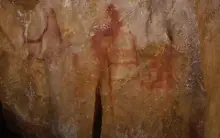|
Spain Cave Art Dated to Neanderthal Times
February 22, 2018 Cave art in Spain has been dated to long, long before modern humans arrived in Europe. 
Scientists now say that the ochre paintings of animals, dots, and geometric signs found in three caves in different parts of the country were done more than 64,000 years ago. The evidence is in the form of cutting-edge technology known as uranium-thorium dating. Carbon dating has long been used to date things from long ago. The new, more accurate method examines traces of thorium and uranium, radioactive elements both, in deposits of carbonate that have settled on the cave walls over time. The team of scientists–from France, Germany, Spain, and the U.K.–examined 60 carbonate samples from caves in Adarles, in the southwest part of Spain; in La Paseiga, in the northeastern part of the country; and in Maltravieso, in the west. The results convinced them that the paintings dated to at least 64,000 years ago and so, the artists must have been Neanderthals, since anatomically modern humans did not arrive in Spain and elsewhere in Mediterranean Europe until 45,000 years ago or so. Some of the most famous early art is in caves in Chauvet and Lascaux, in France. A relatively recent study of Indonesian cave art found that those paintings dated to 40,000 years ago. Those paintings and a small bit found in an El Castillo, Spain, wave are thought to be the oldest painted by human hands yet found. |
Social Studies for Kids |
Social Studies for Kids
copyright 2002–2019
David White




